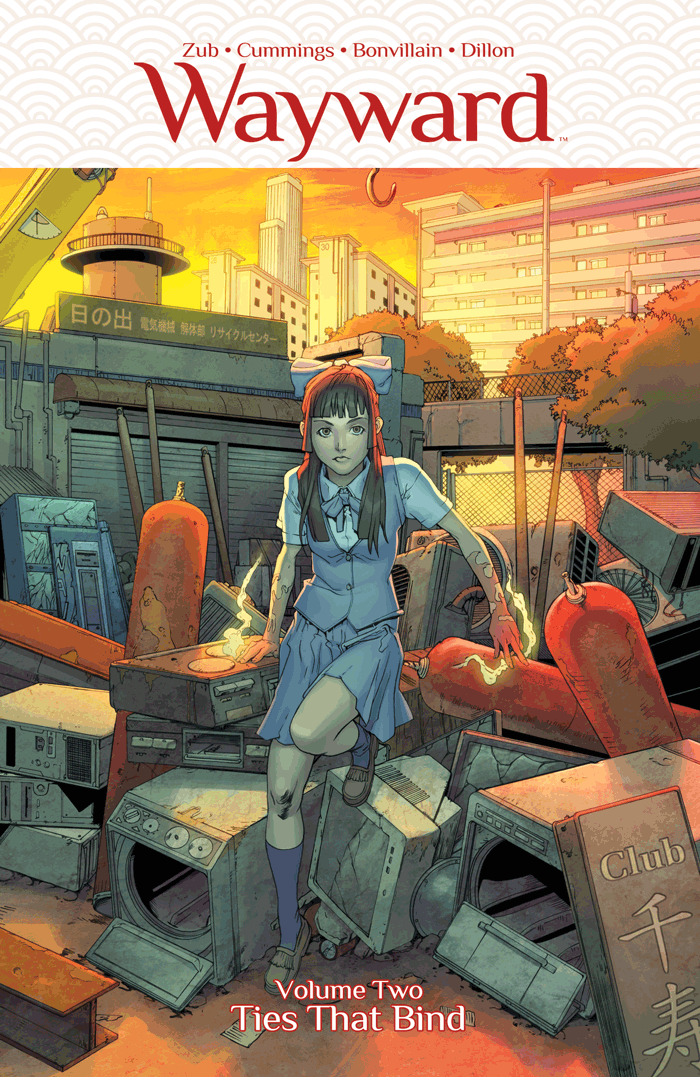Review: Wayward, Vol. 2: Ties That Bind
Comic Review
Wayward, Vol. 2: Ties That Bind
Writer: Jim Zub
Artist: Steve Cummings
Image Comics
Street: 08.26
TL;DR: Reading Wayward is like watching the Google street view of the cats in Hiroshima–perfect. It’s impossible to take your eyes off of and constantly leaving you wanting to share it with your friends.
It’s an unprecedented time for high-quality comics and Wayward has been one of my highest recommendations since its Image Comics debut in 2014. The quirky, gorgeous and, overall, fascinating Wayward continues to prove its spot at the top with the conclusion to a satisfyingly dark second arc: Wayward Vol. 2: Ties That Bind. Initially, my standard pitch for this was, “Imagine Buffy The Vampire Slayer, but replace all the vampires with traditional Japanese folklore monsters.” It has since become a little more nuanced—well, maybe just adding in a few more expletives insisting how excellent it has become since that starting point. It’s a supernatural action-adventure tale about a small group of teenagers taking on some of the most powerful monsters that may or may not secretly be controlling Japan (we just don’t know…yet).
In the first volume, Rori Lane, a half-Japanese, half-Irish girl moves to Tokyo to be closer to her mom and discovers she has some very special abilities that allow her directly interact with spirits and creatures straight out of folklore. Of course, she’s not alone and assembles a team of similarly powered friends to fight the Big Bad characters in the shadows. The short explanation is that the central premise is that everything is connected by a web of reality that’s rapidly unraveling.
However, Rori is now presumed to be dead, so the monster-hunting job is left to the super badass fighting styles of the kawaii Ayane, who is literally “a girl formed from supernatural energies channeled through generations of cats,” and Nikaido, just a normal chill dude who happens to also absorb and manipulate emotions of anyone he encounters. They soon recruit Emi Ohara, a shy and typical polite Japanese schoolgirl who also has some special connection to this web and can take on the physical attributes of manmade materials such as glass and iron. To think that all the ennui-ridden Emi wanted was to have some excitement in her life. Now she’s in the middle of an epic battle that has persisted thousands of years against some of the most menacing yōkai (supernatural monsters). What a life.
Don’t be fooled, this isn’t some weeaboo Avatar fan-fiction. Jim Zub also penned the excellent Samurai Jack comic and it’s clear that he did his research for Wayward, too. The biggest downside to the trade version of this comic is the disturbing lack of essays by translator and folklore expert Zack Davisson. At the end of each individual issue, he provides us with a fascinating in-depth articles about specific monsters and the real Japanese culture that influences the book. While you can easily look up tsuchigumo, the dirt spiders, and what they represent to understand why they’re dubious creatures to encounter, these essays provide more specific insight than a quick glance at Wikipedia. This additional information isn’t stuff the plot requires you to necessarily know, because context makes everything pretty obvious, but it’s that extra academic curiosity that makes the story feel more complete; the essays help us navigate the web in-depth. How much do you know about bakeneko? I had no idea that so many sexy-cat-ladies in manga and anime were derived from prostitutes who turned out to be cats, but now we all do.
The script is paired with some gorgeous art, too. The endcap to issue 6 shows the art process from Steve Cummings‘ rough sketches to Tamra Bonvillain’s full colors and not a color nor line is ever out of place. In the panel they showcase, the green kitsune-bi (foxfire) orbs look like tiny floating universes floating around Emi as she walks down an alley. Wayward could easily have been an all black-and-white manga, but Bonvillain’s vivid colors instill a feeling of eerie reality into the fantasy of it all. Everything from Ayane’s adorable cat-shaped hairdo to each individual cat, spider and thread is beautifully rendered.
So, I love this book. There’s cathartic violence, creepy creatures, evil tricksters and a ton of loose threads that I can’t wait to continue unraveling when issue 11 comes out. –Taylor Hoffman
